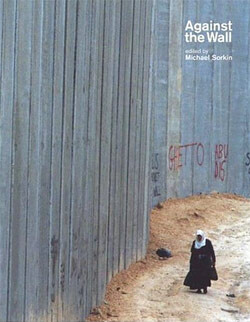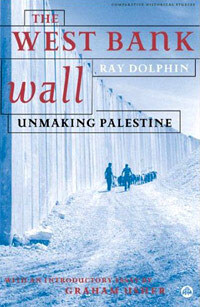The Electronic Intifada 13 August 2007

Now, here are two recent books that take the wall itself as their central subject. Against the Wall is a collection of eighteen essays by practicing and academic architects, visual artists, critics, and activists, including several from Palestine-Israel, edited by Michael Sorkin, the director of the graduate urban design program at the City College of New York whose earlier Palestine-related contribution is the collaborative project The Next Jerusalem: Sharing the Divided City (Monacelli Press, 2002). More than a critical examination specifically of the West Bank wall and its meanings, its intent is to “extrapolate the idea of boundary to the larger workings of global capital” (p. vii). A compelling exposition of this idea is offered by urban theorist Mike Davis, who describes what amounts to a “great wall of capitalism” (p. 89) — the complex system of movement control and surveillance on the United States-Mexico border, around the European Union, and between Australasia and Asia, that constitute a single system intended to cordon off small wealthy enclaves from the vast majority of the global poor. Its characteristic features are militarization, the development of sophisticated technologies of biological control, and the conflation of debates on immigration, “war on terror,” and “war on drugs,” amounting to a constant state of low-intensity warfare on the fringes of this capitalist empire (p. 93).
Several contributions draw on Giorgio Agamben’s concept of “state of exception,” to describe the spaces Israel attempts to create, transforming Palestinians into homo sacer (sacred men), who are included in the juridical order only in the form of their exclusion and reduced to “bare life,” mere biological existence that can be killed without consequence. For Sari Hanafi, this idea is central. Dean MacCannell distinguishes the social and communicational functions of walls from their purported security and defense purposes. Ariella Azoulay and Adi Ophir introduce the concept of an “economy of violence” made up of “spectacular violence” and less visible, but more devastating “suspended violence” (p. 3), of which the West Bank wall is the greatest instrument yet; it must be seen, they argue, not as a departure, but a continuation of decades-old oppressive Israeli systems. Lindsay Bremner, in an essay discussing how perceived skin color was the signifier that formed the moving wall determining all social relations in apartheid South Africa, complements articles by Terry Boullata and Rebecca Solnit (who focuses on the US-Mexican border), and a piece coauthored by Oren Yiftachel and Haim Yacobi. Through their contrasting lenses, each returns to the theme that every fantasy of hermetic closure or separation has been undermined by a reality of porosity, fluidity, resistance, and illicit exchange that constantly reasserts itself against the ever-close, but never attainable purity that the builders of walls in their physical and virtual manifestations desire. The varied styles include a few fairly theoretical passages, and some conversational and even humorous first person pieces such as Suad Amiry’s magical realist encounter with the animals at Qalqilya zoo. Against the Wall provides many challenging insights, and successfully ranges far from its title subject without losing sight of it in unrelated ruminations.

Indeed, the incapacity of the PA to advance and protect Palestinian rights and interests is underscored by Dolphin’s account of the “laggard” official response; it took a full year after Israel first began to destroy Palestinian land to build the wall for the PA to raise the issue with the United States (p. 36). By that time 125 kilometers had already been completed and the Israeli diplomatic and propaganda machine had all but sealed American support (including Ariel Sharon’s presentation to President Bush of a copy of Robert Frost’s poem “Mending Wall,” with its famous last line “Good fences make good neighbors” [p. 37]). When in 2003 Mahmoud Abbas, then PA prime minister, did speak out, his primary motivation was to preserve the PA’s dwindling credibility with the rural masses. The United States, for its part, was only prepared to pay lip service to Palestinian concerns to the extent that this helped shore up Abbas, their man in Ramallah. When Abbas resigned as prime minister, the US pretence of opposition to the wall was immediately dropped.
The West Bank Wall is logically organized, covering the wall/fence system and its technologies and offering insightful analysis of the political genesis and significance of the route Israeli planners staked out, with a particular focus on Jerusalem. Dolphin provides a solid account of the politics around the Palestinians’ taking the case to the International Court of Justice and the international community’s (non)response. The book synthesizes existing data from sources including Israeli and international media, UN documents, and NGO reports, in a compact volume with helpful maps, interspersed with black and white photos and text boxes highlighting particularly poignant stories of the wall’s violence. It will be an excellent resource for students, journalists, advocates, and a general rather than scholarly readership.
Although both books are frank about their authors’ activist and polemical intentions, like much contemporary analysis of the Palestine conflict, neither seriously attempts to move beyond the conventional wisdom supporting the appealing, but always unattainable, simplicity of the two-state solution, even as they forensically reveal how Israel’s settler-colonial project has rendered that vision caduque. In line with mainstream Zionist thought, Sorkin asserts the “impossibility” of Palestinian refugees returning if that would “overwhelm the Jewish character of Israel” (p. xvii). He dimisses nonnationalist or binational solutions, including those advanced by Edward Said, as “romance” and “fantasy” (p. xiv). Insisting that a two-state solution is the sine qua non of a settlement (he acknowledges that not all the contributors to Against the Wall agree with this), he argues that Palestinians and Israelis “should not be expected to reconcile only by becoming the vanguard of new, postnational forms of association” (p. xx). Yet the accounts in both of these volumes raise the unavoidable prospect that as hard as it is to contemplate, that may be for Palestinians and Israelis the last hope for salvation.
Co-founder of The Electronic Intifada, Ali Abunimah is author of One Country: A Bold Proposal to End the Israeli-Palestinian Impasse (Metropolitan Books, 2006). This review was originally published in the Spring 2007 issue of the Journal of Palestine Studies and is reprinted with permission.
Related Links





